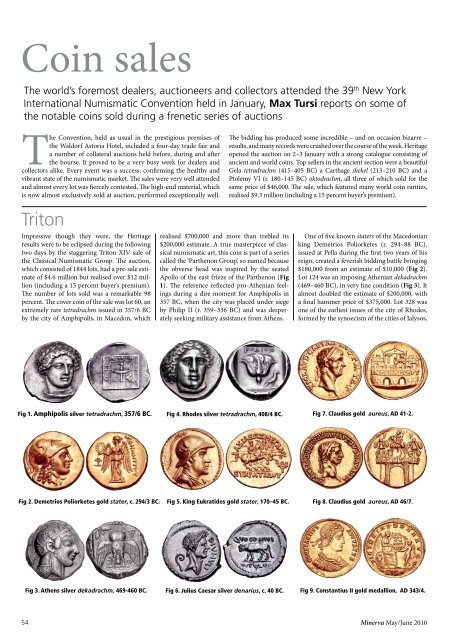Cult of beauty - Minerva
Cult of beauty - Minerva
Cult of beauty - Minerva
You also want an ePaper? Increase the reach of your titles
YUMPU automatically turns print PDFs into web optimized ePapers that Google loves.
Coin sales<br />
The world’s foremost dealers, auctioneers and collectors attended the 39 th New York<br />
International Numismatic Convention held in January, Max Tursi reports on some <strong>of</strong><br />
the notable coins sold during a frenetic series <strong>of</strong> auctions<br />
The Convention, held as usual in the prestigious premises <strong>of</strong><br />
the Waldorf Astoria Hotel, included a four-day trade fair and<br />
a number <strong>of</strong> collateral auctions held before, during and after<br />
the bourse. It proved to be a very busy week for dealers and<br />
collectors alike. Every event was a success, confirming the healthy and<br />
vibrant state <strong>of</strong> the numismatic market. The sales were very well attended<br />
and almost every lot was fiercely contested. The high-end material, which<br />
is now almost exclusively sold at auction, performed exceptionally well.<br />
Triton<br />
Impressive though they were, the Heritage<br />
results were to be eclipsed during the following<br />
two days by the staggering Triton XIV sale <strong>of</strong><br />
the Classical Numismatic Group. The auction,<br />
which consisted <strong>of</strong> 1844 lots, had a pre-sale estimate<br />
<strong>of</strong> $4.6 million but realised over $12 million<br />
(including a 15 percent buyer’s premium).<br />
The number <strong>of</strong> lots sold was a remarkable 98<br />
percent. The cover coin <strong>of</strong> the sale was lot 60, an<br />
extremely rare tetradrachm issued in 357/6 BC<br />
by the city <strong>of</strong> Amphipolis, in Macedon, which<br />
Fig 1. Amphipolis silver tetradrachm, 357/6 BC.<br />
Fig 2. Demetrios Poliorketes gold stater, c. 294/3 BC.<br />
Fig 3. Athens silver dekadrachm, 469-460 BC.<br />
realised $700,000 and more than trebled its<br />
$200,000 estimate. A true masterpiece <strong>of</strong> classical<br />
numismatic art, this coin is part <strong>of</strong> a series<br />
called the ‘Parthenon Group’, so named because<br />
the obverse head was inspired by the seated<br />
Apollo <strong>of</strong> the east frieze <strong>of</strong> the Parthenon (Fig<br />
1). The reference reflected pro-Athenian feelings<br />
during a dire moment for Amphipolis in<br />
357 BC, when the city was placed under siege<br />
by Philip II (r. 359–336 BC) and was desperately<br />
seeking military assistance from Athens.<br />
Fig 4. Rhodes silver tetradrachm, 408/4 BC.<br />
The bidding has produced some incredible – and on occasion bizarre –<br />
results, and many records were crushed over the course <strong>of</strong> the week. Heritage<br />
opened the auction on 2–3 January with a strong catalogue consisting <strong>of</strong><br />
ancient and world coins. Top sellers in the ancient section were a beautiful<br />
Gela tetradrachm (415–405 BC) a Carthage shekel (213–210 BC) and a<br />
Ptolemy VI (r. 180–145 BC) oktodrachm, all three <strong>of</strong> which sold for the<br />
same price <strong>of</strong> $46,000. The sale, which featured many world coin rarities,<br />
realised $9.3 million (including a 15 percent buyer’s premium).<br />
Fig 5. King Eukratides gold stater, 170–45 BC.<br />
Fig 6. Julius Caesar silver denarius, c. 40 BC.<br />
One <strong>of</strong> five known staters <strong>of</strong> the Macedonian<br />
king Demetrios Poliorketes (r. 294–88 BC),<br />
issued at Pella during the first two years <strong>of</strong> his<br />
reign, created a feverish bidding battle bringing<br />
$180,000 from an estimate <strong>of</strong> $10,000 (Fig 2).<br />
Lot 124 was an imposing Athenian dekadrachm<br />
(469–460 BC), in very fine condition (Fig 3). It<br />
almost doubled the estimate <strong>of</strong> $200,000, with<br />
a final hammer price <strong>of</strong> $375,000. Lot 328 was<br />
one <strong>of</strong> the earliest issues <strong>of</strong> the city <strong>of</strong> Rhodes,<br />
formed by the synoecism <strong>of</strong> the cities <strong>of</strong> Ialysos,<br />
Fig 7. Claudius gold aureus, AD 41-2.<br />
Fig 8. Claudius gold aureus, AD 46/7.<br />
Fig 9. Constantius II gold medallion, AD 343/4.<br />
54 <strong>Minerva</strong> May/June 2010

















